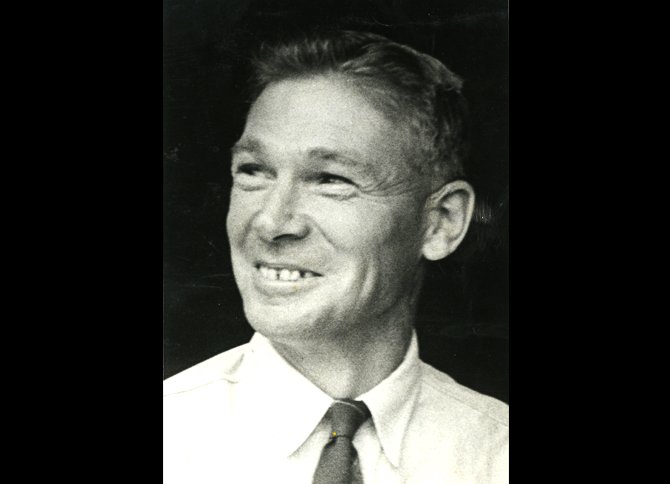Jack spent his career with the Ministry of Works, first working on roading projects and later, on hydro dams. He held the role of District Commissioner of Works for the Otago / Southland region 1960-1971.

Jack Henderson
Early years and education
John Findlay Henderson was born in Dunedin on 30 April 1911. He was the second son of Matthew Cochrane Henderson, a former Dunedin City Electrical Engineer, and his wife Agnes Henderson née Findlay.
Jack, as he was known, completed his early education in Dunedin. He attended High Street Primary School, and King Edward Technical College for his secondary school education.
He then went to the University of Canterbury to study engineering, staying in Rolleston House. He graduated with a Bachelor of Engineering (Civil) in 1934.
Career with the Ministry of Works
Following graduation, Jack joined the Public Works Department. He worked on the Maniototo Irrigation Survey and general irrigation, including the Butchers and Conroy Scheme dams, and roading programmes in the area.
In June 1936 he was appointed as an engineering cadet and employed on construction of the highway through the Kawarau Gorge and the highway between Clyde and Cromwell through the Cromwell Gorge. In 1938 he was transferred to construction of the Haast Pass Road, and the following year moved to Fiordland to work on the Milford Sound access road and Homer tunnel. A significant milestone was reached on 11 March 1940 with the ‘holing through’ of the tunnel.
It was in Fiordland that Jack met his future wife, Airini (Rene) MacGillivray, a nurse who travelled by boat from Bluff to Milford Sound to check on the health of the road gangs. Once married, Jack and Rene lived at Marian, a road camp near the eastern end of Homer Tunnel.
The couple lived in the road camp until November 1941 when Jack was transferred to Auckland to work on the Whenuapai and Hobsonville aerodromes, and to build concrete runways at Whenuapai. Towards the end of World War II, Jack was seconded to the Air Force for a short period, to advise on runway construction in Fiji.
In 1948, Jack transferred to the Auckland office of the Ministry of Works where he worked on general roading construction.
In April 1950, Jack was appointed Engineer responsible for concrete quality for the dams being constructed on the Waikato River. He transferred to Mangakino to supervise the construction of the Maraetai Dam and power station. In September 1952, he took up a similar role on the construction of the Roxburgh Dam on the Clutha River.
In August 1955 Jack was appointed Assistant District Civil Engineer for the Ministry of Works Otago-Southland Region, based at their office in Dunedin.
In 1960 Jack was promoted to District Commissioner of Works. In this role he oversaw the construction of Momona Airport, and the motorway development both to the north and to the south of Dunedin. Land stability and route selection were issues for the northern motorway. The southern motorway and the flood-free highway along the western edge of the Taieri Plain were also major projects of the 1960s.
Jack also served on the National Roads Board for a number of years and remained closely involved with highway projects until his retirement in 1971.
He was Chairman of the Officials Committee which considered the hydro development options for the Clutha River, a document which contributed to the selection of Clyde for the second dam on the river.
As part of his role as the District Commissioner of Works, Jack was the Crown Representative on the Otago Catchment Board. Following his retirement in 1971, he continued his service on the Board, this time as an elected member. He served as Deputy Chairman in 1977 and Chairman, 1978-1979. In total, he served 23 years on the Board.
During his years on the Catchment Board, Jack represented various organisations including the Otago Acclimatisation Society, Executive Committee of the New Zealand Catchment Authorities Association, and the Metropolitan and Provincial executives of the Otago Council.
Sporting interests and retirement
Jack had a lifelong interest in sports. He gained a New Zealand University Blue for Athletics in 1933, the shot put being his forte. He played rugby for University of Canterbury, playing at fullback, but a shoulder injury cut short his playing days. He was a keen golfer and in later years, played lawn bowls for the Roslyn Club in Dunedin, as had his father previously.
In his retirement Jack also spent time restoring valve radios – another life-long interest.
Jack and Rene had three sons and a daughter. Rene died on 2 January 1984 and Jack died on 30 June 1987.
References
“City Man gets Post as District Engineer,” Evening Star, September 24, 1960, 1.
“Down to Earth Engineer Dies,” Otago Daily Times, July 2, 1987, 3.
Harold J. Anderson, Men of the Milford Road (Wellington: Reed, 1975).
Rosslyn J. Noonan, By Design: a brief history of the Public Works Department, Ministry of Works 1870-1970 (Wellington: Government Printer, 1975).
Paul Sorrell ed., The cyclopedia of Otago & Southland (Dunedin: Dunedin City Council, 1999), Vol 1.
Biography by John Henderson
Page last updated 08 June 2021
